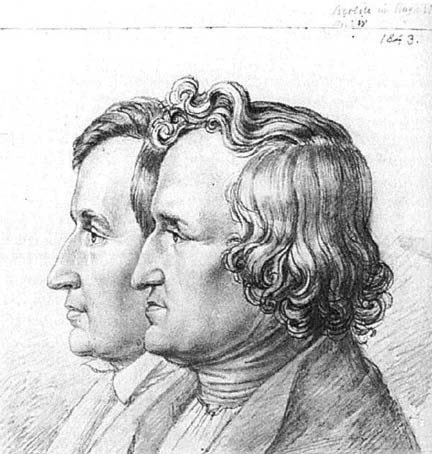Mike Selby
In the early 1800s, two brothers roamed the dark forests of Germany, collecting the ancient myths and folklore of the illiterate peasant class. Originally published as 'Kinder- und Hausmärchen' (Children's and Household Tales), they are known today in the English-speaking world as 'Grimm's Fairy Tales.' The tales collected and organized by Jacob and Wilhelm Grimm are more popular today than ever (simply check one's local movie listings), and continue to be the most translated text in history next only to the Bible.
Yet the brother's story is almost as mythic as their collection.
Jacob and Wilhelm were the oldest of nine children, being raised in a large spacious home on the edge of forest in Northern Hesse. Their father practiced law for diplomats and princes, while their mother stayed at home to raise the children with her numerous servants. All this changed in 1796, when Jacob and Wilhelm's father died suddenly at age 44. The Grimm family found themselves destitute, living on handouts and relying on a variety of kind relatives for shelter. After three of the younger children perished, a distant aunt took them in, ensuring the children continued in school.
Jacob and Wilhelm were extremely bright, and both were accepted into the University of Marburg Law School. Jacob went alone though, as Wilhelm's health was too poor. It was at Marburg were Jacob developed an intense interest in Germany's ancient past. At the time, there was no Germany to speak of. The nation was split up into hundreds of principalities, governed more or less by half-a-dozen separate states, often at war with each other. Napoleon had also invaded, and German roots were being replaced by French culture.
All this combined with his chronic worry about his family caused Jacob to quit school and return home. He took various jobs to support everyone, but spent every single second of free time working on ancient German literature with his brother Wilhelm. Together they created what has been called their 'grand plan,' which was the recovery of "oral and ancient written sources of German legends, anonymous epics, chapbook stories, folk songs and verses in older forms of the language." While the greatest side-effect of their life's work were the fairy tales, the more important aspect at the time was nationalism. A common literary past was seen as the best bet to united Germany as a single country.
In this, the Grimms were not alone. Between the 17th and 19th centuries a type of literary arms race had exploded across Europe. It was seen that main qualification to be recognized as a country was to have ancient tales to back it up. Elias Lonnrot made the case for Finland with 'The Kalevala' ; Denmark's N.S.F. Grundtvig produced 'Danske Folkevisor' and the 'Nordens Mytologi' ; Ireland's Thomas Croker's 'Fairy Legends and Traditions of the South of Ireland' ; and Snorri Sturluson's 'Prose & Poetic Edda' for Iceland. (England, to quote a famous literary historian, "couldn't have cared less.")
No one could do this better than the Grimms though, especially Jacob. His ability to read Old German, and to recognize exactly when and were a word's sound shift had occurred, made him a linguistic genius without peer. There still is a 'Grimm's Law' used today which identifies Germanic words in Indo-European languages. The brothers combined their talents to launch the first phase of their work, the collection of the very oldest and orally passed down folktales.
The tales which come down to us today as 'Grimm's Fairy Tales' do indeed take place in enchanted forests, small cottages, and giant castles. Most of the stories feature nameless characters—a princess, a frog, a king, a stepmother, a witch, etc. It is more than comforting to know that the very first edition of their book begins with "Once upon a time...".
Yet none of these stories came from the peasant class; nor did the Grimms travel anywhere to get them. The tales came from the wealthy and educated aristocracy, whom came to the Grimms to tell them the tales. The majority of the sources were highly literate females, who as often as not mixed up French folklore with German. This is why 'Puss 'n' Boots' appears in the first edition of 'Grimms Fairy Tales,' but is removed from all future ones. Also many of the fairy tales come from other books, albeit very old manuscripts.
None of that should take away any of the mystery, wonder and delight generations continue take away from them. The ageless tales of "Little Red Riding Hood,' 'Snow White,' 'Hansel and Gretel,' and 'Cinderella' continue to help give meaning to the lives of children and adults alike.
Mike Selby is Reference Librarian at the Cranbrook Public Library
